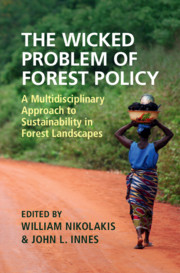 The Wicked Problem of Forest Policy
The Wicked Problem of Forest Policy Book contents
- The Wicked Problem of Forest Policy
- The Wicked Problem of Forest Policy
- Copyright page
- Contents
- Contributors
- 1 The Wicked Problem of Forest Policy
- Part I Wicked Problems and Policies
- 2 Why Forests Matter?
- 3 Forest Certification and Forest Use
- 4 REDD+ Meets Local Realities
- 5 Have Payments for Ecosystem Services Delivered for the Rural Poor?
- 6 Tackling Gender Inequality through Forest-Related Policies and Programmes
- 7 Forestry Crimes and Our Planet
- 8 Forest Bioeconomy Development
- Part II Tools to Address Wicked Problems
- Index
- References
8 - Forest Bioeconomy Development
Markets and Industry Structures
from Part I - Wicked Problems and Policies
Published online by Cambridge University Press: 24 July 2020
- The Wicked Problem of Forest Policy
- The Wicked Problem of Forest Policy
- Copyright page
- Contents
- Contributors
- 1 The Wicked Problem of Forest Policy
- Part I Wicked Problems and Policies
- 2 Why Forests Matter?
- 3 Forest Certification and Forest Use
- 4 REDD+ Meets Local Realities
- 5 Have Payments for Ecosystem Services Delivered for the Rural Poor?
- 6 Tackling Gender Inequality through Forest-Related Policies and Programmes
- 7 Forestry Crimes and Our Planet
- 8 Forest Bioeconomy Development
- Part II Tools to Address Wicked Problems
- Index
- References
Summary
The 2030 Agenda for Sustainable Development and its Sustainable development Goals (SDGs) and the Paris Agreement on climate change provide a license to change the existing global economic model. Production and consumption needs to be transformed to be sustainable so that we can live within our planetary boundaries. An essential part of this transformation will be a forest-based circular bioeconomy, which builds on the world’s biggest land-based natural capital – forests – and the synergies of the circular economy and bioeconomy concepts. Biology, science, technology, resource efficiency and sustainability are laying the foundations for this transformation. Within this context, forest bio-based products have emerged that can substitute fossil-based materials like plastics, chemicals, synthetic textiles, cement and many other materials. This chapter analyses this ongoing transformation, focusing on forest-based products, and examines what this role looks like by exploring trends in current market structures and forest products in this transformation, and asks how will these new emerging bioeconomy markets develop? Central to this chapter are other questions such as what role do polices play in the transformation, and how do the forest companies and institutions evolve in the coming decades? It is important to acknowledge that there are many ecosystem services related to forest bioeconomy that play an even greater role in sustaining life on earth – and therefore facilitating the bioeconomy - than the products we address in this chapter.
- Type
- Chapter
- Information
- The Wicked Problem of Forest PolicyA Multidisciplinary Approach to Sustainability in Forest Landscapes, pp. 231 - 258Publisher: Cambridge University PressPrint publication year: 2020


